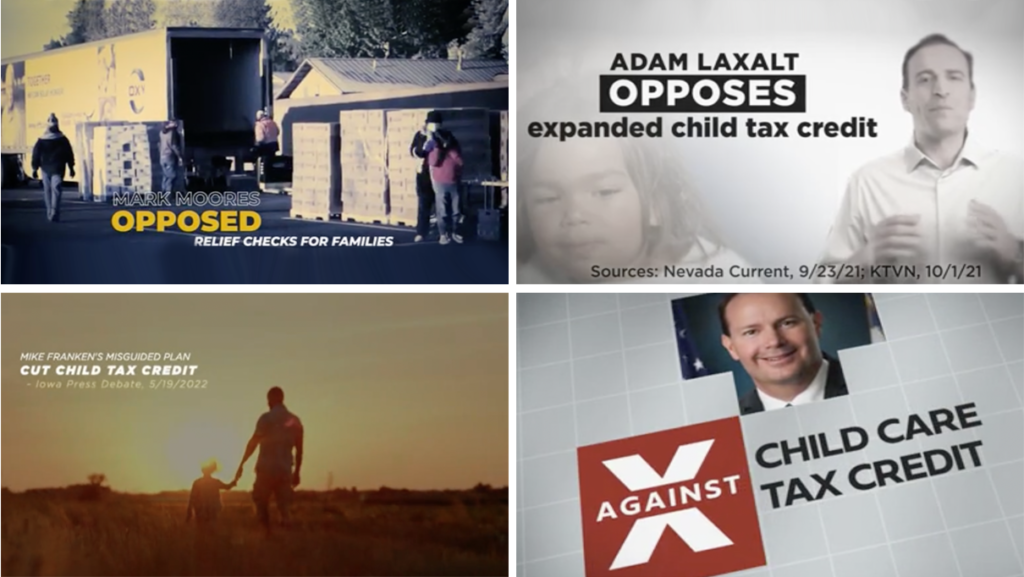2022 Campaign Advertising Highlights: Child Tax Credit References Largely Absent in Ads
By Erika Franklin Fowler, Natália de Paula Moreira, and Jielu Yao
As the 2022 midterm elections race to their conclusion on Tuesday, there has been a lot of discussion about the content and issue focus of the ads flooding the airwaves, with abortion topping the list for Democrats while Republican messaging has closed with an emphasis on government spending, inflation, and economic concerns about cost of living.
In a multipart series, the COMM team seeks to unpack a set of issues that have not featured prominently in campaign advertising and the implications of what that low volume might mean for politics and policy in 2023. In our first installment of less-covered topics in 2022 advertising, we take a look at the low volume of discussion of the child tax credit – a legislative achievement that has traditionally had substantial bipartisan support and was associated with dramatic reductions in child poverty. Despite these well-documented successes, in the period from January 1 through October 30, 2022, fewer than one percent of all federal advertising mentioned child tax credits.
One might have expected that discussing the expanded child tax credits provided to families would be a no-brainer topic for the midterms for several reasons. For one, child tax credits are overwhelmingly popular and have traditionally garnered bipartisan support, and in fact, both parties could claim credit for expanding them in recent years. The 2017 Tax Cuts and Jobs Act temporarily doubled the credit through 2025, and the 2021 American Rescue Plan further expanded the credit and paid out half of the credit in monthly installments upfront. A March 2021 YouGov/The Economist survey found that 69% of those who were aware of the American Rescue Plan, supported an expansion of the child tax credit with majorities across the partisan spectrum (82% of Democrats, 68% of Independents, and 52% of Republicans) agreeing. Although support among Republicans has waned slightly, a strong majority (59%, including 75% of Democrats, 55% of Independents, and 44% of Republicans) of the public support renewing the program, according to a July 2022 Morning Consult survey. In addition to broad public support, research evidence has demonstrated that child tax credit provisions cut child poverty in half and decreased food insufficiency (with demonstrated increases in food insufficiency when the credits went away again).
With broad public support for the provisions and evidence that they reduce child hunger and poverty, why didn’t the child tax credit feature prominently in 2022 midterm advertising when economic cost of living concerns were also top of mind for citizens? We took a look at all of the advertising that explicitly mentioned the issue to see how it was discussed.
Although ads that mentioned the child tax credit were more likely to support Democrats, even the Republican ads that mentioned the issue did so either to tout child tax credit expansions or to attack the opponent for being against the policy. In other words, all of the ads that mentioned the child tax credit – regardless of whether they came from pro-Democratic or pro-Republican sponsors – talked about the child tax credit in a way to convey support for the policy of providing more support for families. This support came in one of two forms, either (1) through describing the candidate as supporting expanding child tax credits and/or payments to families (see Figure 1) or (2) through attacks on their opponent for opposing or attempting to cut child tax credits (see Figure 2).
Figure 1: Screenshots from television advertising claiming credit for supporting child tax credit expansions

Figure 2: Screenshots from television advertising attacking opponents for opposing the child tax credit

As noted above, although the volume of mentions of child tax credits in advertising was very low, more of the ads that mentioned the topic were from pro-Democratic advertisers. However, there were some Republican sponsored airings including an ad by Tim Scott saying he is responsible for doubling the credit (via the Tax Cuts and Jobs Act of 2017) and an ad by Republican Chuck Grassley attacking his Democratic opponent Mike Franken for proposing to cut the child tax credit by opposing the same.
One important feature that is clear from the content of the advertising that mentions the policy: partisans on both sides of the aisle seem to understand that providing support to families through a child tax credit is popular.
Perhaps part of the reason that the expanded child tax credit did not get more attention in campaign advertising is in part because both parties could claim partial credit for expanding them, which complicates any narrative in which parties and candidates try to distinguish themselves on Election Day. In addition, since the tax credits were not renewed in 2022 – they were left on the cutting room floor in the negotiations with Joe Manchin over the Inflation Reduction Act – Democrats may not have wanted to own up to their responsibility for the fact that these payments went away, which makes messaging on the topic much harder.
Nevertheless, politicians across the aisle agree that the child tax credit is popular, which also suggests that they recognize the impact the child tax credit had on American families. Post-election politics will help determine its future.
______
The COMM team includes members of the Wesleyan Media Project (WMP). Since the 2010 election cycle, WMP has been providing real-time information on the extent of corporate and union spending in federal election campaigns across the country, who specifically is doing that spending and which candidates are benefiting. In the Fall of 2022, the COMM team will be providing periodic commentaries about the ways in which discourse in political ads is relevant to health equity.
This post was funded by the Robert Wood Johnson Foundation (Grant no. 79754). The views expressed here do not necessarily reflect the views of the foundation.